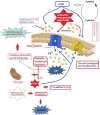Thermo-Sensitive TRP Channels: Novel Targets for Treating Chemotherapy-Induced Peripheral Pain
- PMID: 29326595
- PMCID: PMC5733463
- DOI: 10.3389/fphys.2017.01040
Thermo-Sensitive TRP Channels: Novel Targets for Treating Chemotherapy-Induced Peripheral Pain
Abstract
Abnormal Ca2+ channel physiology, expression levels, and hypersensitivity to heat have been implicated in several pain states following treatment with chemotherapeutic agents. As members of the Ca2+ permeable transient receptor potential (TRP), five of the channels (TRPV1-4 and TRPM2) are activated by different heat temperatures, and two of the channels (TRPA1 and TRPM8) are activated by cold temperature. Accumulating evidences indicates that antagonists of TRPA1 and TRPM8 may protect against cisplatin, oxaliplatin, and paclitaxel-induced mitochondrial oxidative stress, inflammation, cold allodynia, and hyperalgesia. TRPV1 was responsible from the cisplatin-induced heat hyperalgesia and mechanical allodynia in the sensory neurons. TRPA1, TRPM8, and TRPV2 protein expression levels were mostly increased in the dorsal root (DRG) and trigeminal ganglia by these treatments. There is a debate on direct or oxaliplatin-induced oxidative cold stress dependent TRPA1 and TRPV4 activation in the DRG. Involvement of molecular pathways such as cysteine groups, glutathione metabolism, anandamide, cAMP, lipopolysaccharide, proteinase-activated receptor 2, and mitogen-activated protein kinase were also indicated in the oxaliplatin and paclitaxel-induced cold allodynia. In this review, we summarized results of five temperature-regulated TRP channels (TRPA1, TRPM8, TRPV1, TRPV2, and TRPV4) as novel targets for treating chemotherapy-induced peripheral pain.
Keywords: allodynia; chemotherapeutic agents; hyperalgesia; oxidative stress; thermo sensitive TRP channels.
Figures


Similar articles
-
Oxaliplatin-induced changes in expression of transient receptor potential channels in the dorsal root ganglion as a neuropathic mechanism for cold hypersensitivity.Neuropeptides. 2018 Feb;67:95-101. doi: 10.1016/j.npep.2017.12.002. Epub 2017 Dec 15. Neuropeptides. 2018. PMID: 29274843
-
Acute cold hypersensitivity characteristically induced by oxaliplatin is caused by the enhanced responsiveness of TRPA1 in mice.Mol Pain. 2012 Jul 28;8:55. doi: 10.1186/1744-8069-8-55. Mol Pain. 2012. PMID: 22839205 Free PMC article.
-
Sex-related differences in oxaliplatin-induced changes in the expression of transient receptor potential channels and their contribution to cold hypersensitivity.Neurosci Lett. 2022 Sep 25;788:136863. doi: 10.1016/j.neulet.2022.136863. Epub 2022 Sep 5. Neurosci Lett. 2022. PMID: 36067900
-
[Role of Transient Receptor Potential Channels in Paclitaxel- and Oxaliplatin-induced Peripheral Neuropathy].Yakugaku Zasshi. 2016;136(2):287-96. doi: 10.1248/yakushi.15-00214. Yakugaku Zasshi. 2016. PMID: 26831807 Review. Japanese.
-
Roles of Transient Receptor Potential Ankyrin 1 in Oxaliplatin-Induced Peripheral Neuropathy.Biol Pharm Bull. 2017;40(7):947-953. doi: 10.1248/bpb.b17-00243. Biol Pharm Bull. 2017. PMID: 28674258 Review.
Cited by
-
TLR4 induced TRPM2 mediated neuropathic pain.Front Pharmacol. 2024 Sep 12;15:1472771. doi: 10.3389/fphar.2024.1472771. eCollection 2024. Front Pharmacol. 2024. PMID: 39329114 Free PMC article. Review.
-
Therapeutic Effect of Tetrapanax papyriferus and Hederagenin on Chronic Neuropathic Pain of Chronic Constriction Injury of Sciatic Nerve Rats Based on KEGG Pathway Prediction and Experimental Verification.Evid Based Complement Alternat Med. 2020 Jun 13;2020:2545806. doi: 10.1155/2020/2545806. eCollection 2020. Evid Based Complement Alternat Med. 2020. PMID: 32617100 Free PMC article.
-
Selenium and Neurological Diseases: Focus on Peripheral Pain and TRP Channels.Curr Neuropharmacol. 2020;18(6):501-517. doi: 10.2174/1570159X18666200106152631. Curr Neuropharmacol. 2020. PMID: 31903884 Free PMC article. Review.
-
The Challenge of Global Warming in Water Buffalo Farming: Physiological and Behavioral Aspects and Strategies to Face Heat Stress.Animals (Basel). 2023 Oct 5;13(19):3103. doi: 10.3390/ani13193103. Animals (Basel). 2023. PMID: 37835709 Free PMC article. Review.
-
Steroids and TRP Channels: A Close Relationship.Int J Mol Sci. 2020 May 27;21(11):3819. doi: 10.3390/ijms21113819. Int J Mol Sci. 2020. PMID: 32471309 Free PMC article. Review.
References
Publication types
LinkOut - more resources
Full Text Sources
Other Literature Sources
Research Materials
Miscellaneous

